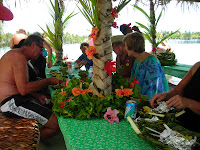On Monday 21st we entered the magnificent harbour of Pago Pago in American Samoa Pago Pago is on the largest of seven islands and it is called Tutuila with a population of approx.60,000 and is only one third of the size of the Isle of Wight . The adjacent independent nation of Western Samoa has nine islands and Aurora is visiting Apia
We have visited this place before 3 years ago and done an organized tour so this time we just wandered around as the town is very small and quite close to the ship. Many stalls had been set up on the quay selling sarongs, flowery shirts, carvings, straw hats and baskets and wonderful floral arrangements using exotic flowers. We even got a fridge magnet which had not been available on our last visit.
Walking to the left from the ship we passed the magnificent colonial Governors House and reached a beach where we found many of the crew relaxing in the water and playing volleyball with the locals. It was great to watch as they need to relax because they work so hard to make our trip so wonderful. The temperature was only about 28C but humidity was very high with passing showers so by the time we had walked the 20mins or so back into the town our tee shirts were soaked with perspiration. The town is not pretty so we made for a watering hole called Sadie Thompsons that we know from last time. Somerset Maugham wrote about Sadie Thompson and Pago Pago
Sailaway at 1600 was spoilt by a tropical shower or two but after passing Flower Pot Rock and much blowing of sirens from the pilot boat we left the volcano astern and set course through the islands of Fiji towards New Caledonia and our next port Noumea
Incidentally we advance the clocks 24 hours tonight which is confusing some people. Instead of being 11hours behind GMT we will be 13hours ahead and Tuesday will not exist! Eleven people on board will have no birthday this year!
Today we received the terrible news about another earthquake in Christchurch New Zealand
On Thursday night it was Maureen and Colin´s (one of our table companions who leave in Brisbane
We woke on Friday to find ourselves berthing on another container terminal and some passengers who obviously could not sleep were off ashore soon after 0800. We had a leisurely breakfast and got the shuttle bus into town after 0930. There we found a 1 hour city tour which would leave us at the beach later for only $15 and took that. We drove through the rather uninspiring town but visited 2 highpoints for the view and then were dropped at Lemon Bay Beach Marina
Back on board after a little shopping it was not long before Aurora was giving 3 short blasts and was off again steaming into the sunset and our next port Brisbane





















































